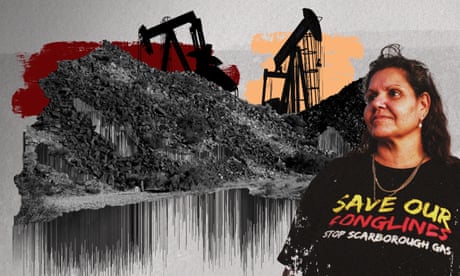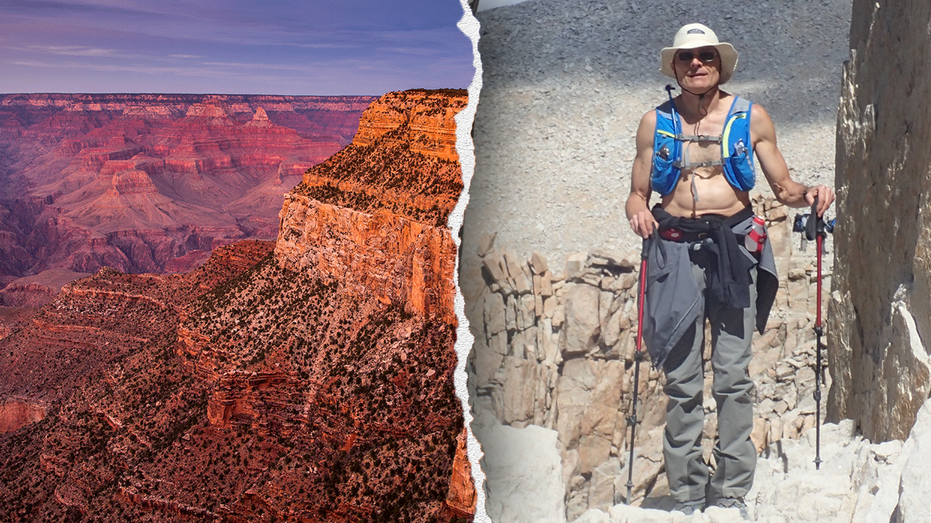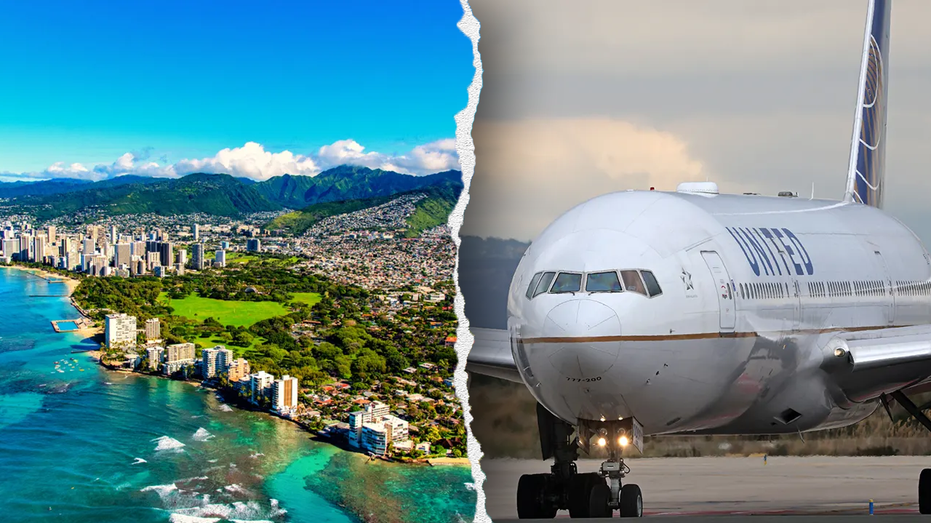- by foxnews
- 23 May 2025
‘Our ancestors are in the rocks’: Australian gas project threatens ancient carvings - and emissions blowout
‘Our ancestors are in the rocks’: Australian gas project threatens ancient carvings - and emissions blowout
- by theguardian
- 12 May 2022
- in news

As the last of the sun's rays curl away from the coast in Australia's remote north-west, Josie Alec opens her arms and sings in traditional language to a mass of ochre-coloured rocks along Hearson's Cove. But her voice competes with the low rumble of a gas production plant less than a kilometre away, its flared emissions lightly hazing the sky above the beach.
This is the duality of what First Nations people refer to as Murujuga country, home to one of the world's largest and oldest collections of rock carvings as well as one of the largest new fossil fuel developments in Australia in a decade.
Taking in the Burrup peninsula and the nearby Dampier archipelago, the culturally rich area has an estimated 1m ancient petroglyphs. Some of the images, including illustrations of long-extinct species such as the thylacine and flat-tailed kangaroo, are believed to date back nearly 50,000 years.
Traditional custodians such as Alec and fellow Kuruma Marthudunera woman Raelene Cooper come to Hearson's Cove to connect with nature, and the thousands of generations of their people who lived in the country before them, through song.
"You feel them in your heart and your soul, our ancestors in the rocks," Alec says. "We have to wake them up, sing them we're here, sing them we're still protecting them. Then you hear the wisdom that they have for the past and the future. And it's time for listening."
But just who is listening - and who is being listened to - is a live question in Murujuga. While the historical and cultural significance of the art is uncontested, and the subject of a Unesco world heritage bid, it sits uneasily alongside the industrial city of Karratha, a settlement of about 23,000 that is about to double down on fossil fuel extraction.
Production in the region is expected to expand significantly after Woodside Energy, an Australian petroleum company, announced in November that it would proceed with a US$12bn liquified natural gas (LNG) development.
The scale of Woodside's proposal is vast. It would open an untapped gas field nearly 250 miles (400km) off the Australian coast and connect it to the mainland via a pipeline through an area rich in marine biodiversity, while expanding its existing Pluto LNG processing plant near Karratha to more than double its current capacity.
Opponents say the Scarborough-to-Pluto project could lock in new polluting infrastructure expected to run beyond 2050. Researchers at Climate Analytics estimate it could lead to 1.37bn tonnes of greenhouse gases being pumped into the atmosphere across its lifetime - roughly three times the total annual emissions of Australia or the UK.
Woodside and the conservative Australian government claim the Scarborough development would be good for the country and the planet. Australia's prime minister, Scott Morrison, told business leaders that when he heard Woodside had made a final decision to invest in Scarborough he celebrated with "a bit of a jig". "I could not be more thrilled about that," he said.
This is broadly a bipartisan view. The Labor opposition, narrowly favoured to win a national election on 21 May, also supports gas industry expansion. The Western Australian Labor state government declared it would change the law to ensure Scarborough could proceed if a legal challenge by conservationists was successful.
Australia has done little to cut greenhouse gas emissions since the government was elected in 2013. Its 2030 reduction target is less than half that set by the UK and EU, and it has committed about A$1bn in public funding to a "gas-fired recovery" from the Covid crisis.
Under pressure, Morrison set a net zero emissions goal shortly before the Cop26 UN climate summit in Glasgow in November - but his plan requires no emissions reductions and Australia was widely condemned by international leaders as a laggard in addressing the climate crisis.
Opposition to the Scarborough project has come from environmental groups and a small but determined section of the local Indigenous community. They argue it is a "carbon bomb" that would be disastrous for the climate, that construction would destroy unique local marine life and acidic pollution from the production facility would damage the irreplaceable rock art.
"Across the board, Scarborough is just a terrible project," says Maggie Wood, the acting executive director of the Conservation Council of Western Australia. "But I would say the likelihood of it going ahead is high. The state and federal governments argue continual expansion of fossil fuels is a job creator, but we know that is fundamentally untrue - it doesn't bring in much money from taxes and royalties, it doesn't create that many jobs and the gas is mostly going to be exported. The reality is that fossil fuel companies have a hold over Australian politics."
Part of the problem, Wood and others argue, is that the cumulative impact of the Scarborough development had not been properly assessed before it was approved by national and state authorities. Instead it was broken up and submitted piecemeal for approval.
The project is a continuation of the dramatic expansion of the Australian gas export industry across the continent's north over the past decade. LNG exports have quadrupled in volume over that time to reach about 80m tonnes, with sales forecast to top US$50bn this year, twice that of the thermal coal industry. Australia now runs neck-and-neck with Qatar in the race to be the world's biggest gas exporter.
Scarborough is the most advanced of several proposals to expand that further. All are at odds with a warning last year from the head of the International Energy Agency, Fatih Birol, that no new gas or oilfields should be opened if the slim prospect of limiting global heating to 1.5C above pre-industrial levels was to survive.
The impact of gas expansion is clearly visible in Karratha. The city is saturated in fossil fuel money that helps pay for upmarket coffee shops and wine bars, large modern homes for gas and iron ore mining families and well-kept four-lane highways to production facilities.
Many Indigenous families who have lived in the region for generations largely reside in older, comparatively rundown satellite towns such as Roebourne, a half-hour drive from Karratha's air-conditioned shopping malls. Most residents in the region, including a significant proportion of the Indigenous community, strongly support continued expansion of the fossil fuel sector that keeps the area afloat.
But the gas industry is also having an impact on the region's cultural heritage. In some places, rocks have been disturbed to make way for infrastructure, and a recent peer-reviewed study found evidence that industrial pollution was "actively degrading" Murujuga rock art.
Carmen Lawrence, a former Labor state premier and ex-chair of the Australian Heritage Council, said it was clear that gas processing was having a significant effect on petroglyphs and further expansion would only increase the duration and severity of the impact.
She likened the management of the risk to the mistakes that two years ago resulted in the miner Rio Tinto's catastrophic destruction of an Aboriginal heritage site in an explosion at nearby Juukan Gorge.
Cooper, a former chair of the Murujuga Aboriginal Corporation, describes the rocks at Hearson's Cove as "our church, our parliament house". She says damage is already visible, and believes world heritage status for the region is the best hope for protection.
"There is no price you can put on this place," she says. "People see the rock as just a rock with some artwork on it but, to us, they speak. They tell a story. They are alive."
Woodside disputes suggestions its expansion on the Burrup poses a risk to the petroglyphs. A spokesperson said research had not demonstrated that its operations had any impact, and it was supporting a "world-best-practice programme to monitor and protect the rock art" that was co-managed by the local Murujuga Aboriginal Corporation and government officials.
"It is Woodside's view that traditional custodians must be central to the management of their heritage," the spokesperson said, adding the company had consulted with them and responded to requests for environmental monitoring, archaeological and ethnographic surveys and access to independent expert advice.
In response to the claim the project would not create many jobs, the spokesperson said Scarborough would create 3,200 positions during construction and 300 ongoing jobs in Western Australia, including an expected 70 in Karratha.
The company hopes Scarborough will be the start of a new wave of fossil fuel development in the country's north-west. In an interview with the Australian Financial Review, Woodside's chief executive, Meg O'Neill, said she hoped the fallout from Russia's invasion of Ukraine would allow it to kickstart consideration of two other gas mega-projects that had stalled during the pandemic - the Sunrise gas reservoir in the Timor Sea and the Browse development off Western Australia.
The latter had been written off by many analysts and campaigners as commercially unviable and would be significantly more carbon-intensive than Scarborough.
Woodside's fossil fuel footprint is expected to expand even more dramatically next month if its shareholders rubber-stamp a deal in which it would merge its petroleum assets with those of the global miner BHP. It would allow BHP to shed a massive decommissioning liability for its oil assets and overnight make Woodside a global top 10 oil and gas company with investments in the Gulf of Mexico, Caribbean, Algeria and Australia.
The company argues this is consistent with climate commitments that it says are aligned with the goals of the Paris agreement. It has a target of cutting its scope 1 and 2 emissions - those on site and from the electricity it uses - by 30% by 2030, and an "aspiration" to reach net zero emissions "by 2050 or sooner".
It says avoiding and reducing emissions is its "first priority" but the use of carbon offsets - cuts in emissions elsewhere to allow it to pollute - and the development of carbon capture and storage (CCS) technology, which is not yet used at any scale, will be important.
It aims to help reduce its scope 3 emissions - those released by its customers when they eventually burn the gas - by investing in "new energy products" such as hydrogen, ammonia and CCS. It has set a US$5bn investment target in these plans by 2030, less than half the expected cost of the Scarborough development.
Analysts argue that Woodside's claims on emissions are full of holes. Bill Hare, the chief executive of Climate Analytics and a recent appointee to the UN secretary general's expert group looking at the best way for non-state actors to reach net zero emissions, says Woodside "does not have a scientific leg to stand on" on emissions reduction.
"I don't really like the term greenwashing but there's no other word for it. Woodside is engaged in extreme greenwashing," he says. "It has no real net zero plan. It is all about using offsets to make it look like it is acting when it is not."
Hare says the annual emissions from Scarborough gas would be globally significant, with a conservative analysis suggesting they would be enough to, in effect, wipe out the emissions reduction from all the rooftop solar panels installed in Australia twice over. Roughly one in three Australian homes have solar systems.
On the BHP deal, Hare says Woodside may come to regret the scale of the gargantuan rehabilitation costs the company will inherit for relatively short-term gain. "I really don't see this is working out very well."
Woodside is unlikely to hear the same messages from the Australian political system. Its board includes former cabinet ministers from the Liberal and Labor parties, and it has successfully lobbied governments. For example, it was part of a campaign that persuaded the state government to shelve a proposal that would have required new large fossil fuel developments to offset all emissions.
Scarborough still faces a legal challenge over whether the carbon dioxide emitted during production should be considered a pollutant, but even if successful it would probably lead only to a change in the conditions under which it could be developed.
It leaves little reason for hope for the traditional custodians of Hearson's Cove - but still they are here. As dusk wears on, Alec and Cooper are joined by Robyn Churnside, a Ngarluma elder who has been fighting fossil fuel and mining developments since the 1970s. She says her family is used to being minority voices of dissent and will persist.
"It's about time the world listened to First Nations people, because we've been here long, long time," she says. "Our spirit in this land will never rest. It needs protection."
- by foxnews
- descember 09, 2016
United Airlines flight returns to Hawaii after concerning message found on bathroom mirror; FBI investigating
United Airlines Flight 1169 to Los Angeles returned to Hawaii after a "potential security concern" aboard the plane. The FBI and police are investigating.
read more


